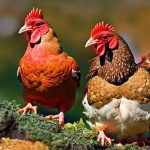Selecting the appropriate breed of baby chickens requires careful consideration of several factors. The primary consideration is the intended purpose for raising chickens, whether for egg production, meat, or as pets. Different breeds excel in specific areas.
For instance, Leghorns and Rhode Island Reds are known for high egg production, while Cornish Cross and Freedom Rangers are suitable for meat production. Silkies and Orpingtons are popular choices for those seeking friendly, docile chickens as pets. Climate is another crucial factor in breed selection.
Some breeds are better adapted to cold weather, such as Plymouth Rock and Wyandotte, which demonstrate cold hardiness. Conversely, Mediterranean breeds like Leghorns and Minorcas are more suited to warmer climates. The available space for raising chickens is also important, as some breeds are better suited for free-ranging, while others adapt well to confinement.
Thorough research into various chicken breeds and their specific characteristics is essential for making an informed decision. This research should encompass factors such as egg production rates, meat quality, temperament, climate adaptability, and space requirements. By carefully considering these aspects, one can select the most appropriate breed of baby chickens to meet their specific needs and circumstances.
Table of Contents
- 1 Setting Up a Cozy and Safe Brooder
- 2 Providing the Right Nutrition for Baby Chickens
- 3 Maintaining Cleanliness and Hygiene in the Brooder
- 4 Monitoring and Managing the Temperature
- 5 Socializing and Handling Baby Chickens
- 6 FAQs
- 6.1 What do baby chickens need to thrive at home?
- 6.2 What kind of housing is suitable for baby chickens?
- 6.3 What temperature should the brooder be for baby chickens?
- 6.4 What should baby chickens eat?
- 6.5 How do you keep baby chickens safe from predators?
- 6.6 How do you care for the health of baby chickens?
Key Takeaways
- Consider the breed’s temperament, egg-laying ability, and space requirements when choosing baby chickens.
- Create a warm and secure brooder with proper bedding, heat source, and ventilation for baby chickens.
- Provide a balanced diet with starter feed, water, and occasional treats for baby chickens’ growth and health.
- Keep the brooder clean by regularly changing bedding, cleaning waterers and feeders, and preventing moisture buildup.
- Monitor and regulate the temperature in the brooder to ensure baby chickens are comfortable and healthy.
Setting Up a Cozy and Safe Brooder
Providing a Safe and Comfortable Environment
The key is to provide enough space for the chicks to move around freely while keeping them safe from predators and other hazards. The brooder should be lined with absorbent bedding such as pine shavings or straw to provide a soft and comfortable surface for the chicks to walk on. It’s important to keep the bedding clean and dry to prevent any health issues such as respiratory problems or infections.
Maintaining the Right Temperature and Access to Essentials
A heat source such as a heat lamp or a brooder heater should be provided to maintain the right temperature for the chicks. The temperature in the brooder should be around 95 degrees Fahrenheit for the first week and then gradually decreased by 5 degrees each week until the chicks are fully feathered. In addition to warmth, the brooder should also provide access to fresh water and chick starter feed at all times.
Monitoring and Maintaining the Brooder
The water should be provided in shallow containers to prevent drowning, and the feed should be placed in shallow dishes or feeders to make it easily accessible to the chicks. It’s important to monitor the chicks closely during the first few days to ensure that they are eating and drinking properly. Overall, setting up a cozy and safe brooder is crucial for the health and well-being of baby chickens as they grow and develop.
Providing the Right Nutrition for Baby Chickens

Providing the right nutrition is crucial for the healthy growth and development of baby chickens. A good quality chick starter feed that is specifically formulated for young chicks should be provided from day one. This feed is high in protein and essential nutrients that are necessary for healthy bone and muscle development, as well as feather growth.
It’s important to ensure that the feed is fresh and free from mold or contaminants that could harm the chicks. In addition to chick starter feed, it’s important to provide access to clean and fresh water at all times. Chicks can quickly become dehydrated, especially in warm weather, so it’s crucial to check their water supply regularly and ensure that it is free from contaminants.
Waterers should be placed at a height that is easily accessible to the chicks but prevents them from getting into it and potentially drowning. As the chicks grow, their nutritional needs will change, so it’s important to transition them onto a grower feed when they reach around 6-8 weeks of age. This feed has lower protein content than chick starter feed but still provides essential nutrients for healthy growth and development.
It’s important to monitor the chicks’ growth and adjust their feed accordingly to ensure that they are getting the right nutrition at each stage of their development. Providing the right nutrition is crucial for the healthy growth and development of baby chickens. A good quality chick starter feed that is specifically formulated for young chicks should be provided from day one.
This feed is high in protein and essential nutrients that are necessary for healthy bone and muscle development, as well as feather growth. It’s important to ensure that the feed is fresh and free from mold or contaminants that could harm the chicks. In addition to chick starter feed, it’s important to provide access to clean and fresh water at all times.
Chicks can quickly become dehydrated, especially in warm weather, so it’s crucial to check their water supply regularly and ensure that it is free from contaminants. Waterers should be placed at a height that is easily accessible to the chicks but prevents them from getting into it and potentially drowning. As the chicks grow, their nutritional needs will change, so it’s important to transition them onto a grower feed when they reach around 6-8 weeks of age.
This feed has lower protein content than chick starter feed but still provides essential nutrients for healthy growth and development. It’s important to monitor the chicks’ growth and adjust their feed accordingly to ensure that they are getting the right nutrition at each stage of their development.
Maintaining Cleanliness and Hygiene in the Brooder
Maintaining cleanliness and hygiene in the brooder is essential for preventing diseases and ensuring the health of baby chickens. The bedding in the brooder should be cleaned regularly to remove droppings, spilled feed, and any other debris that could harbor bacteria or parasites. This will help prevent respiratory issues and infections that can arise from poor hygiene.
In addition to cleaning the bedding, it’s important to regularly clean and sanitize waterers and feeders to prevent bacterial growth. Waterers should be emptied, cleaned with hot soapy water, rinsed thoroughly, and refilled with fresh water daily. Feeders should also be cleaned regularly to prevent mold growth and contamination of feed.
It’s also important to monitor the overall cleanliness of the brooder environment by regularly inspecting for any signs of mold, mildew, or pests such as mites or lice. Any signs of infestation should be addressed immediately by cleaning and disinfecting the brooder thoroughly. Overall, maintaining cleanliness and hygiene in the brooder is crucial for preventing diseases and ensuring the health of baby chickens as they grow.
Maintaining cleanliness and hygiene in the brooder is essential for preventing diseases and ensuring the health of baby chickens. The bedding in the brooder should be cleaned regularly to remove droppings, spilled feed, and any other debris that could harbor bacteria or parasites. This will help prevent respiratory issues and infections that can arise from poor hygiene.
In addition to cleaning the bedding, it’s important to regularly clean and sanitize waterers and feeders to prevent bacterial growth. Waterers should be emptied, cleaned with hot soapy water, rinsed thoroughly, and refilled with fresh water daily. Feeders should also be cleaned regularly to prevent mold growth and contamination of feed.
It’s also important to monitor the overall cleanliness of the brooder environment by regularly inspecting for any signs of mold, mildew, or pests such as mites or lice. Any signs of infestation should be addressed immediately by cleaning and disinfecting the brooder thoroughly. Overall, maintaining cleanliness and hygiene in the brooder is crucial for preventing diseases and ensuring the health of baby chickens as they grow.
Monitoring and Managing the Temperature
Monitoring and managing the temperature in the brooder is crucial for the health and well-being of baby chickens. Chicks are unable to regulate their body temperature effectively during their first few weeks of life, so it’s important to provide a warm environment that mimics the conditions under a mother hen. A reliable thermometer should be used to monitor the temperature in the brooder regularly.
The temperature should be maintained at around 95 degrees Fahrenheit for the first week of life, then gradually decreased by 5 degrees each week until the chicks are fully feathered at around 6-8 weeks of age. It’s important to ensure that there are areas within the brooder where chicks can move away from direct heat if they become too warm. This can be achieved by providing a heat lamp with adjustable height or by using multiple heat sources placed at different locations within the brooder.
It’s also important to monitor how chicks respond to temperature changes by observing their behavior. Chicks that huddle together under the heat source may be too cold, while chicks that move away from it may be too warm. Adjusting the height or number of heat sources can help maintain an optimal temperature within the brooder.
Overall, monitoring and managing the temperature in the brooder is crucial for ensuring that baby chickens are comfortable and healthy as they grow. Monitoring and managing the temperature in the brooder is crucial for ensuring that baby chickens are comfortable and healthy as they grow. Chicks are unable to regulate their body temperature effectively during their first few weeks of life, so it’s important to provide a warm environment that mimics the conditions under a mother hen.
A reliable thermometer should be used to monitor the temperature in the brooder regularly. The temperature should be maintained at around 95 degrees Fahrenheit for the first week of life, then gradually decreased by 5 degrees each week until the chicks are fully feathered at around 6-8 weeks of age. It’s important to ensure that there are areas within the brooder where chicks can move away from direct heat if they become too warm.
This can be achieved by providing a heat lamp with adjustable height or by using multiple heat sources placed at different locations within the brooder. It’s also important to monitor how chicks respond to temperature changes by observing their behavior. Chicks that huddle together under the heat source may be too cold, while chicks that move away from it may be too warm.
Adjusting the height or number of heat sources can help maintain an optimal temperature within the brooder. Overall, monitoring and managing the temperature in the brooder is crucial for ensuring that baby chickens are comfortable and healthy as they grow.

Importance of Daily Interaction
Spending time with them daily will help them become accustomed to human interaction, making them easier to handle as they grow older.
Handling Baby Chickens with Care
When handling baby chickens, it’s essential to do so gently and calmly to avoid causing them stress or injury. It’s best to approach them from above rather than reaching from behind where they can’t see you coming. This will help them feel more secure when being handled.
It’s also important not to handle baby chickens too much during their first few days of life as they need time to adjust to their new environment. However, spending time near them without handling them can help them become familiar with your presence. As they grow older, gradually increasing handling time will help them become more comfortable with human interaction. This will make tasks such as health checks, wing clipping, or moving them into new enclosures much easier as they grow into adult birds.
Long-term Benefits
Overall, socializing and handling baby chickens regularly will help them become friendly and docile adult birds that are easy to manage.
If you’re interested in keeping baby chickens at home, you may also want to learn about the mating season for turkeys. Understanding the breeding habits of turkeys can provide valuable insight into the care and management of poultry. Check out this article for more information on this topic.
FAQs
What do baby chickens need to thrive at home?
Baby chickens, also known as chicks, need a warm and draft-free environment, access to clean water and nutritious food, and protection from predators.
What kind of housing is suitable for baby chickens?
A suitable housing for baby chickens is a brooder, which can be a cardboard box, plastic tub, or a specially designed brooder. It should be warm, well-ventilated, and have a non-slippery surface.
What temperature should the brooder be for baby chickens?
The brooder temperature should be around 95°F (35°C) for the first week, and then reduced by 5°F (2.8°C) each week until the chicks are fully feathered, usually around 6 weeks old.
What should baby chickens eat?
Baby chickens should be fed a commercial chick starter feed, which is high in protein and essential nutrients. They can also be given small amounts of fresh fruits and vegetables as treats.
How do you keep baby chickens safe from predators?
To keep baby chickens safe from predators, their housing should be secure and predator-proof. Additionally, they should be supervised when outside and brought indoors at night.
How do you care for the health of baby chickens?
Caring for the health of baby chickens involves providing them with clean water, a balanced diet, and regular monitoring for signs of illness. It’s also important to keep their living environment clean and dry.
Meet Walter, the feathered-friend fanatic of Florida! Nestled in the sunshine state, Walter struts through life with his feathered companions, clucking his way to happiness. With a coop that’s fancier than a five-star hotel, he’s the Don Juan of the chicken world. When he’s not teaching his hens to do the cha-cha, you’ll find him in a heated debate with his prized rooster, Sir Clucks-a-Lot. Walter’s poultry passion is no yolk; he’s the sunny-side-up guy you never knew you needed in your flock of friends!







